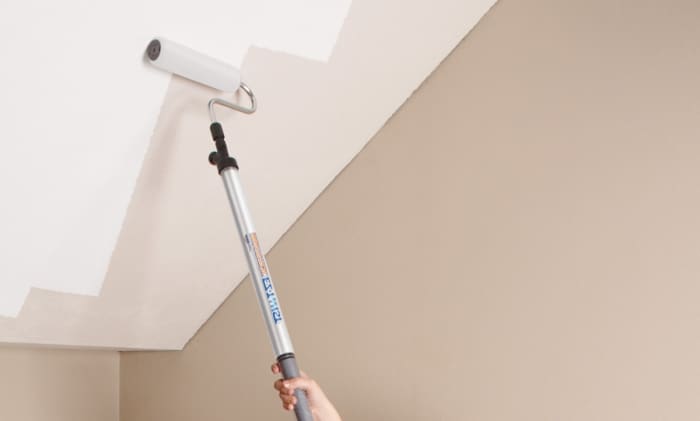The Encyclopedia of Scrapbooking Tools & Techniques
Matt is a professional painter and freelance writer, sharing his knowledge, house-painting tips, and product reviews.

Don't make the job of painting a ceiling harder than it needs to be!
Let's face it: painting ceilings isn't fun. But if you use the right tools and techniques, you can paint your ceiling a lot faster and with less fatigue.
18-inch Paint Roller
One of the fastest ways to roll out a large ceiling is with an 18-inch paint roller, instead of a standard nine-inch roller. An 18-inch paint roller covers more surface area faster and reduces overlapping. These large paint rollers do get a little heavy from paint saturation, but you can roll out your ceiling a lot faster.
An 18-inch roller is best for a larger ceiling, not a small ceiling, like one in a bathroom. The best roller nap size for painting a ceiling is 3/4-inch. The 3/4-inch nap holds more paint to cover the ceiling faster than using a 1/2-inch nap.
Extension Pole
I cringe when I see people on home improvement shows rolling paint on walls and ceilings without an extension pole. Why make your project harder? An extension pole makes it a lot easier to roll paint on walls and ceilings with less strain on your arms and back. I'd never paint a ceiling without one.
I've used different painting extension poles over the years, but the Purdy brand poles last the longest. The locking mechanism on cheap extension poles break faster. For a standard eight-foot ceiling, a pole that extends a maximum of eight feet works best. For painting high ceilings, a 16-foot pole is needed.
A painting pole, equipped with a ceiling paint roller and an extendable paintbrush, makes it possible to paint an entire ceiling without even using a ladder. An extendable paintbrush and an 18-inch roller are both awesome for high ceilings.
Extendable Paintbrush
An extendable paintbrush is a must-have tool for cutting-in hard-to-reach corners, or to simply paint ceiling corners of walls that will be painted anyway. There are brush adapters that hold your paintbrush, or extendable paintbrushes, which are the better option of the two.
I use the Goose Neck extendable and bendable paintbrush for nearly all of the ceilings I paint. I love this tool. The paintbrush itself screws onto your extension pole and the neck of the brush bends to any angle you want for cutting-in at different angles. The tool allows you to paint any ceiling without having to climb up and down a ladder.
Paint the Ceiling Before the Walls
The biggest mistake made when painting a whole room is painting the ceiling after the walls. When done this way, all the walls need to covered with plastic, creating additional work and wasted plastic.
Always paint the ceiling first, followed by the walls, then you don't have to worry about paint sprinkles falling onto the walls, since they'll be painted anyway. If paint drips on the wall, wipe them off with a rag.
If you're only painting the ceiling, the walls need to be covered with plastic before rolling. Cut-in the corners and around fixtures before rolling.
How to Prep the Ceiling for Paint
Make sure the room is carefully covered with plastic and drop cloths before doing any work. If the walls aren't going to be painted, you'll need to cover them with plastic. The best way to mask walls with plastic is using a 3M hand masking tool. This is a must-have tool for interior painting.
Prime Water Stains and Nicotine Stains
Stains from nicotine and water damage need to be primed first before painting. If there are only a couple stains, you can spot prime them using a spray can of primer, but if the ceiling is in bad condition, the whole surface should be primed. The best primer to use is an oil-based primer sealer. Zinsser Cover Stain primer works great.
If the new paint color is much lighter than what's on the surface, the drywall should be primed with a latex primer to help with coverage. Preprite Latex Primer, or Multi-Purpose Primer, both from Sherwin Williams, are good choices.
Repair the Drywall
Drywall imperfections on ceilings can stand out like a sore thumb if neglected. Patch drywall cracks and nail pops, using joint compound. Crawford's spackle in the green can works great for patching small nail holes. The repair patches should be primed before painting.
Best White Paint for Ceilings
Unless you're painting a bathroom, flat paint (non-shiny) is great for ceilings with noticeable drywall seams and imperfections. The best bathroom ceiling paint finish is eggshell or satin.
- Sherwin Williams CHB: An inexpensive paint I've used on ceilings for a long time is CHB from Sherwin Williams. CHB paint dries completely flat, hiding surface imperfections really well. The paint coverage is excellent, even in one coat if the colors are similar. This product isn't washable at all and should not be used in a bathroom.
- Sherwin Williams Duration Home: Duration Home is a low VOC paint that covers really well. The flat finish is a true flat, not shiny. You can use the satin, or semi-gloss finish. on bathroom ceilings for mildew resistance. Dirt and stains wipe off easier than other paints I've used.
- Sherwin Williams Super Paint: The coverage with Super Paint is excellent. One coat is often enough for solid coverage. Super Paint flat is a great ceiling paint option outside of a bathroom or a kitchen. The flat finish is truly flat with no sheen to it.
This content is accurate and true to the best of the author's knowledge and is not meant to substitute for formal and individualized advice from a qualified professional.
© 2012 Matt G.
The Encyclopedia of Scrapbooking Tools & Techniques
Source: https://dengarden.com/home-improvement/How-to-Paint-A-Ceiling
0 Response to "The Encyclopedia of Scrapbooking Tools & Techniques"
Post a Comment